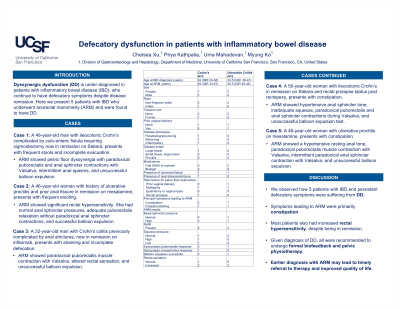Monday Poster Session
Category: IBD
P2244 - Dyssynergic Defecation in Patients With Inflammatory Bowel Disease
Monday, October 23, 2023
10:30 AM - 4:15 PM PT
Location: Exhibit Hall

Has Audio
- CX
Chelsea Xu, MD
University of California, San Francisco
San Francisco, California
Presenting Author(s)
Award: Presidential Poster Award
Chelsea Xu, MD1, Priya Kathpalia, MD1, Uma Mahadevan, MD2, Myung Ko, MD1
1University of California, San Francisco, San Francisco, CA; 2University of California San Francisco, San Francisco, CA
Introduction: Dyssynergic defecation (DD) is underdiagnosed in patients with inflammatory bowel disease (IBD), who continue to have defecatory symptoms despite disease remission. Here we present 5 patients with IBD who underwent anorectal manometry (ARM) and were found to have DD.
Case Description/Methods: Case 1 is a 48-year-old man with ileocolonic Crohn’s complicated by colo-enteric fistula requiring sigmoidectomy now in remission on Stelara, who had symptoms of frequent stools and incomplete evacuation. ARM showed pelvic floor dyssynergia with paradoxical puborectalis and anal sphincter contractions with Valsalva, intermittent anal spasms, and unsuccessful balloon expulsion. In Case 2, a 46-year-old woman with history of ulcerative proctitis and prior anal fissure in remission on mesalamine, was referred to ARM for frequent stooling. Although she had normal anal sphincter pressures, adequate puborectalis relaxation without paradoxical anal sphincter contractions, and successful balloon expulsion, she had significant rectal hypersensitivity. In Case 3, a 32-year-old man with Crohn's colitis previously complicated by anal strictures, now in remission on infliximab, presented for ARM to evaluate straining and incomplete defecation. ARM showed paradoxical puborectalis muscle contraction with Valsalva, altered rectal sensation, and unsuccessful balloon expulsion. Case 4 is a 50-year-old woman with ileocolonic Crohn’s in remission on Stelara and rectal prolapse status post rectopexy, who presented with constipation. ARM showed hypertensive anal sphincter tone, inadequate squeeze, paradoxical puborectalis and anal sphincter contractions during Valsalva, and unsuccessful balloon expulsion test. In Case 5, a 46-year-old woman with ulcerative proctitis on mesalamine, presented for ARM to evaluate constipation. ARM showed a hypertensive resting anal tone, paradoxical puborectalis muscle contraction with Valsalva, intermittent paradoxical anal sphincter contraction with Valsalva, and unsuccessful balloon expulsion.
Discussion: We observed how 5 patients with IBD and persistent defecatory symptoms were suffering from DD. Symptoms leading to ARM were primarily constipation. Most patients also had increased rectal hypersensitivity, despite being in remission. Given diagnosis of DD, all were recommended to undergo formal biofeedback and pelvic physiotherapy. Earlier diagnosis with ARM may lead to timely referral to therapy and improved quality of life.
Disclosures:
Chelsea Xu, MD1, Priya Kathpalia, MD1, Uma Mahadevan, MD2, Myung Ko, MD1. P2244 - Dyssynergic Defecation in Patients With Inflammatory Bowel Disease, ACG 2023 Annual Scientific Meeting Abstracts. Vancouver, BC, Canada: American College of Gastroenterology.
Chelsea Xu, MD1, Priya Kathpalia, MD1, Uma Mahadevan, MD2, Myung Ko, MD1
1University of California, San Francisco, San Francisco, CA; 2University of California San Francisco, San Francisco, CA
Introduction: Dyssynergic defecation (DD) is underdiagnosed in patients with inflammatory bowel disease (IBD), who continue to have defecatory symptoms despite disease remission. Here we present 5 patients with IBD who underwent anorectal manometry (ARM) and were found to have DD.
Case Description/Methods: Case 1 is a 48-year-old man with ileocolonic Crohn’s complicated by colo-enteric fistula requiring sigmoidectomy now in remission on Stelara, who had symptoms of frequent stools and incomplete evacuation. ARM showed pelvic floor dyssynergia with paradoxical puborectalis and anal sphincter contractions with Valsalva, intermittent anal spasms, and unsuccessful balloon expulsion. In Case 2, a 46-year-old woman with history of ulcerative proctitis and prior anal fissure in remission on mesalamine, was referred to ARM for frequent stooling. Although she had normal anal sphincter pressures, adequate puborectalis relaxation without paradoxical anal sphincter contractions, and successful balloon expulsion, she had significant rectal hypersensitivity. In Case 3, a 32-year-old man with Crohn's colitis previously complicated by anal strictures, now in remission on infliximab, presented for ARM to evaluate straining and incomplete defecation. ARM showed paradoxical puborectalis muscle contraction with Valsalva, altered rectal sensation, and unsuccessful balloon expulsion. Case 4 is a 50-year-old woman with ileocolonic Crohn’s in remission on Stelara and rectal prolapse status post rectopexy, who presented with constipation. ARM showed hypertensive anal sphincter tone, inadequate squeeze, paradoxical puborectalis and anal sphincter contractions during Valsalva, and unsuccessful balloon expulsion test. In Case 5, a 46-year-old woman with ulcerative proctitis on mesalamine, presented for ARM to evaluate constipation. ARM showed a hypertensive resting anal tone, paradoxical puborectalis muscle contraction with Valsalva, intermittent paradoxical anal sphincter contraction with Valsalva, and unsuccessful balloon expulsion.
Discussion: We observed how 5 patients with IBD and persistent defecatory symptoms were suffering from DD. Symptoms leading to ARM were primarily constipation. Most patients also had increased rectal hypersensitivity, despite being in remission. Given diagnosis of DD, all were recommended to undergo formal biofeedback and pelvic physiotherapy. Earlier diagnosis with ARM may lead to timely referral to therapy and improved quality of life.
Disclosures:
Chelsea Xu indicated no relevant financial relationships.
Priya Kathpalia indicated no relevant financial relationships.
Uma Mahadevan: AbbVie – Consultant. Boehringer Ingelheim – Consultant. Bristol Myers Squibb – Consultant. Celltrion – Consultant. Eli Lilly – Consultant. Gilead – Consultant. Janssen – Consultant. Pfizer – Consultant. Prometheus Biosciences – Consultant. Protagonist Therapeutics – Consultant. Rani Therpeutics – Consultant. Roivant – Consultant. Takeda – Consultant.
Myung Ko indicated no relevant financial relationships.
Chelsea Xu, MD1, Priya Kathpalia, MD1, Uma Mahadevan, MD2, Myung Ko, MD1. P2244 - Dyssynergic Defecation in Patients With Inflammatory Bowel Disease, ACG 2023 Annual Scientific Meeting Abstracts. Vancouver, BC, Canada: American College of Gastroenterology.

